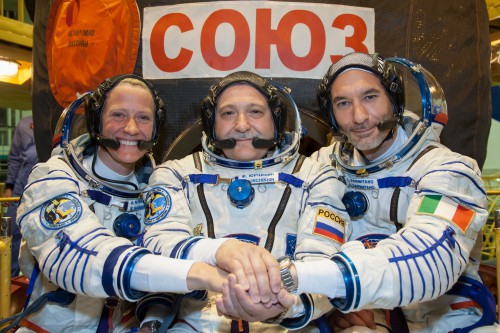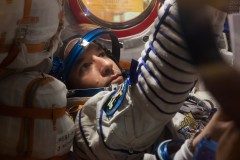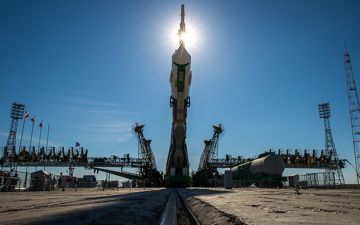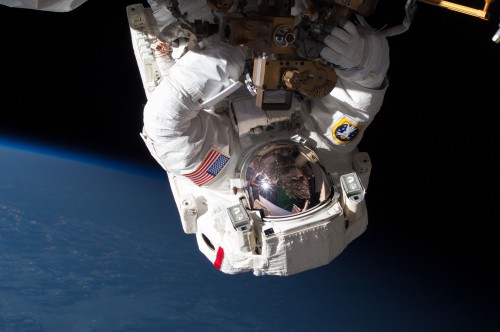
The International Space Station is set to return to its normal six-person strength this week, with the launch and docking of Soyuz TMA-09M and its crew of Russian cosmonaut Fyodor Yurchikhin, Italian astronaut Luca Parmitano, and NASA’s Karen Nyberg. Liftoff of the mission—the fifth ISS expedition to include a long-duration representative of the European Space Agency (ESA)—will occur from the Baikonur Cosmodrome in Kazakhstan at 4:31 p.m. EDT Tuesday (2:31 a.m. local Kazakh time on Wednesday). A “fast rendezvous” profile will bring the Soyuz to a docking with the space station’s Rassvet module six hours and four orbits after launch, whereupon Yurchikhin, Parmitano, and Nyberg will form the second half of Expedition 36, under the command of Pavel Vinogradov.
The Soyuz TMA-09M spacecraft arrived at Baikonur on 27 March and spent several weeks undergoing pre-flight checkout and integration. A few days later, on 1 April, Parmitano tweeted about a launch delay … only to be exposed by Nyberg in a tweet of her own, which revealed it to be an April Fool’s prank by the Italian astronaut. Earlier this month, the three crew members completed their final exams with “excellent” scores and, together with their backups, arrived at the desolate launch site on 16 May. Rollout of the giant Soyuz rocket—a descendant of the vehicle which lofted Yuri Gagarin into space—to the pad took place yesterday (Sunday). After being transported horizontally by train, it was raised into a vertical position, preparatory to launch. This prompted a flurry of excited Twitter messages from Nyberg and Parmitano, together with Soyuz TMA-09M backup crew members Koichi Wakata and Rick Mastracchio.

Tuesday’s scheduled launch will be the second piloted ISS mission to follow the same-day rendezvous and docking profile, after Soyuz TMA-08M delivered Pavel Vinogradov, Aleksandr Misurkin, and Chris Cassidy to the station on 28 March. Such rapid dockings are nothing new—all three Skylab crews in the early 1970s arrived at their orbital home a mere eight or nine hours after launch—but it has been typical during ISS operations to follow a longer, two-day approach, which proved more economical in terms of propellant expenditure and the demands of celestial mechanics. However, the confines of Russia’s tiny Soyuz are cramped and highly stressful and often exacerbate sensations of nausea and motion sickness. Getting crews to the station sooner, though hugely complex, was considered highly desirable.
Space analyst James Oberg, writing last year, noted that the ISS fast-rendezvous plan involved a ballet of between four and six thruster firings to create the proper conditions for an early docking. “The destination in space,” wrote Oberg, “must be lined up much more precisely in a narrow ‘slot’ in the sky. With the two-day profile, that destination could be anywhere halfway along the ISS’ round-the-world orbital track … but with the fast-track rendezvous, the target must be maneuvered in advance into a segment of the target’s orbit that is only 20 degrees wide at the time of the spacecraft’s launch.” Last August, Russia’s unmanned Progress M-16M resupply craft demonstrated the concept by completing a docking, just six hours after liftoff. This was followed, in March, by the first piloted trial, involving the Soyuz TMA-08M crew.
“It’s a really exciting and interesting concept to do,” explained Chris Cassidy in his pre-flight NASA interview. “Typically, we’ll launch on one day, go to bed, be up that whole second day with a few tasks and activities, but not much significant activity, and then go to sleep again and wake up and rendezvous on that third day. We’ll scrunch that whole timeline down into about a six-hour period. The interesting thing from a human point of view is we don’t have time to take off our space suits, so we’ll be strapped into our seats for the whole duration of that six-hour period, plus the pre-launch activities. It’ll be a long day and a lot of time in the suits.”

It will be an equally long day for Yurchikhin, Parmitano, and Nyberg. They will be helped into their Sokol launch and entry suits about four hours ahead of Tuesday’s liftoff and should be in their specially contoured seats aboard the Soyuz TMA-09M descent module about two hours later. They will participate in a series of checks and a minute before launch the Soyuz rocket will be transferred to its internal power supplies. At T-10 seconds, the engine turbopumps will be at full speed, followed five seconds later by confirmation that the engines themselves are at maximum thrust. This will result in the retraction of the pad’s fueling tower and a spectacular launch into the darkened Baikonur sky.
Within a minute of clearing the tower, the rocket will be traveling in excess of 1,100 mph, and at T+118 seconds the four tapering strap-on boosters will be jettisoned, as planned, leaving the “core” alone to complete the push into low-Earth orbit. By the two-minute mark, Yurchikhin, Parmitano, and Nyberg will have passed 3,350 mph and, shortly thereafter, the escape tower and launch shroud will separate, exposing Soyuz TMA-09M to vacuum. Four minutes and 58 seconds after leaving the desolate steppe of Central Asia, the core booster will be jettisoned at an altitude of about 105.6 statute miles and the third and final stage will ignite, boosting the Soyuz to a velocity of more than 13,420 mph. Finally, when the third stage separates, about nine minutes after launch, Yurchikhin, Parmitano, and Nyberg will be in space.
The fast-rendezvous plan will then kick into action and is expected to produce a docking at Rassvet at 10:16 p.m. EDT Tuesday. After customary pressure checks, hatches will be opened about 90 minutes later. Although Vinogradov, Misurkin, and Cassidy completed this rapid rendezvous in March, Soyuz TMA-09M differs slightly in that it will be the first to include only one Russian crew member and two foreign astronauts.
Much drama has surrounded the ISS in recent weeks, with a planned spacewalk from the station’s Russian segment in April and a contingency excursion from the U.S. segment less than three weeks ago. Five more EVAs are planned in the summer—three involving Yurchikhin and Misurkin and two by Cassidy and Parmitano—to accomplish a range of repair, maintenance, and preparatory tasks. On 26 June, Yurchikhin and Misurkin will replace a fluid flow regulator on the Zarya control module, the oldest part of the station. “It’s now 15 years old,” Yurchikhin explained, “and … it continues to work, but the rule to give the station more life, we should change this for a new one.” The duo will also remove a gamma and optical radiation device from the Zvezda service module, photograph and sample multi-layer insulation, and test the Kurs rendezvous hardware.

Two more EVAs by Yurchikhin and Misurkin will follow on 15 and 21 August and are devoted to preparing the Russian segment for the arrival of the long-delayed Nauka Multi-Purpose Laboratory Module (MLM), whose launch is tentatively scheduled for December 2013. During the excursions, the cosmonauts will route power feeders and networking cables from Zarya’s pressurized adaptor to the Poisk module to transfer electrical power from the U.S. segment to the MLM. They will also set up exterior experiments and photograph samples of thermal insulation. In the meantime, Chris Cassidy and Luca Parmitano are slated to support a pair of EVAs on 9 July and 16 July. These will see the astronauts heavily involved in the routing of power and data cables for the MLM, as well as removing and replacing a Space-to-Ground Transmitter Receiver Controller, installing a radiator grapple bar, and retrieving a mast camera from the Mobile Base System. They will also fit the first of two jumper cables onto the station’s Z-1 truss, recover samples from the Materials ISS Experiment (MISSE), replace a camera on the Japanese exposed facility, and perform “get-ahead” tasks.
With the drama of the EVAs keeping the entire Expedition 36 crew busy throughout the summer, Vinogradov and his team will welcome a steady train of visitors, including Europe’s Automated Transfer Vehicle (ATV)-4 “Albert Einstein” in June, Russia’s Progress M-20M in July, and Japan’s Kounotori-4 (“White Stork”) in August. Expedition 36 crewmen Vinogradov, Misurkin, and Cassidy will return to Earth on 11 September, with command of the station handed over to Yurchikhin to herald the start of Expedition 37. Barely 24 hours after the departure of their comrades, on 12 September, according to the current manifest, Orbital Sciences Corp. will launch a month-long demonstration mission of its Cygnus cargo ship atop the Antares booster.
Looking further ahead, the second half of Expedition 37—Soyuz TMA-10M crewmen Oleg Kotov, Sergei Ryazansky, and Mike Hopkins—will launch from Baikonur on 25 September, returning the ISS to six-person strength. And, if the schedule holds, in early November the station will host as many as nine crew members simultaneously. According to NASASpaceflight.com, an EVA from the Russian segment by Kotov and Ryazansky is planned for 9 November, and the arrival of Soyuz TMA-11M crewmen Mikhail Tyurin, Rick Mastracchio, and Koichi Wakata has been correspondingly brought forward to 7 November.
With Yurchikhin, Parmitano, and Nyberg slated to land on 11 November, this will create a temporary nine-person ISS population for the first time since the end of the shuttle era. Ordinarily, the international partners operate a system of “indirect” crew rotations, in which a given subset of an increment will depart before its replacement arrives—reducing a crew from six to three, then back to six—and it would appear that the “direct” rotation planned in November is based on operational concerns, rather than the beginning of a new crew-rotation policy.
Want to keep up-to-date with all things space? Be sure to “Like” AmericaSpace on Facebook and follow us on Twitter:@AmericaSpace
Missions » ISS » Soyuz TMA-M » TMA-09M »


